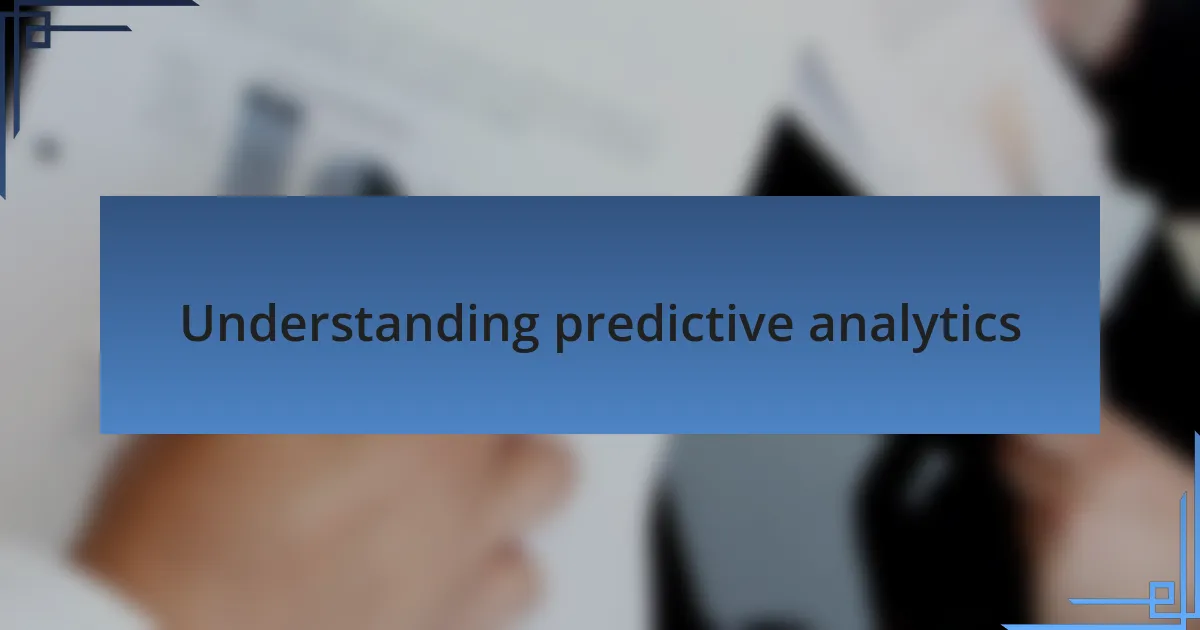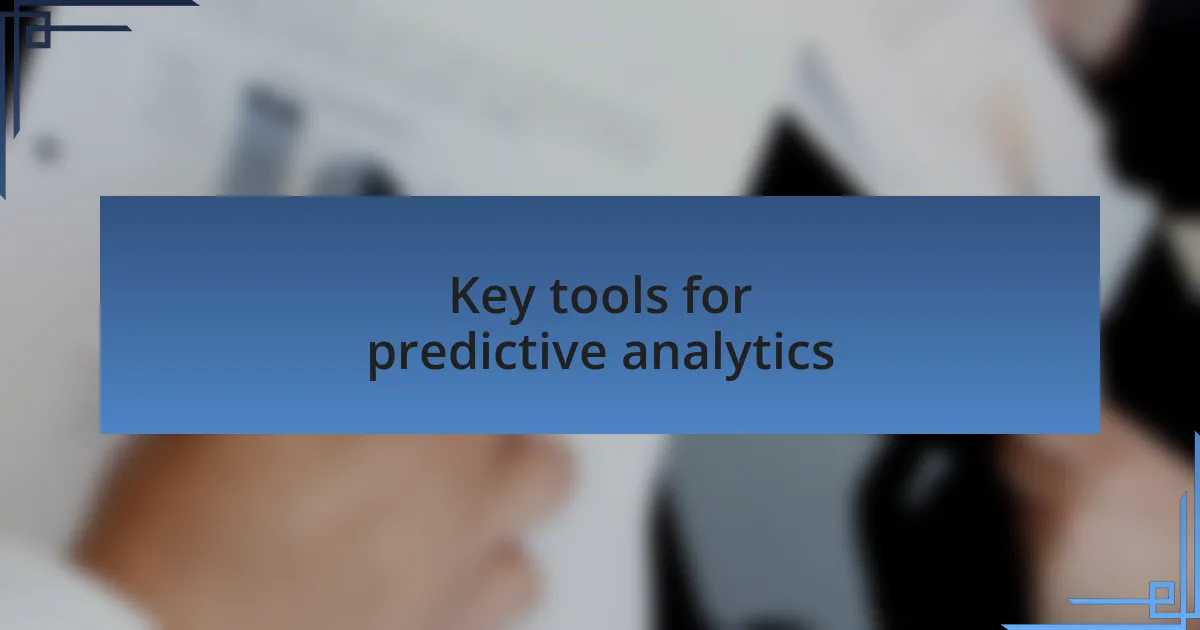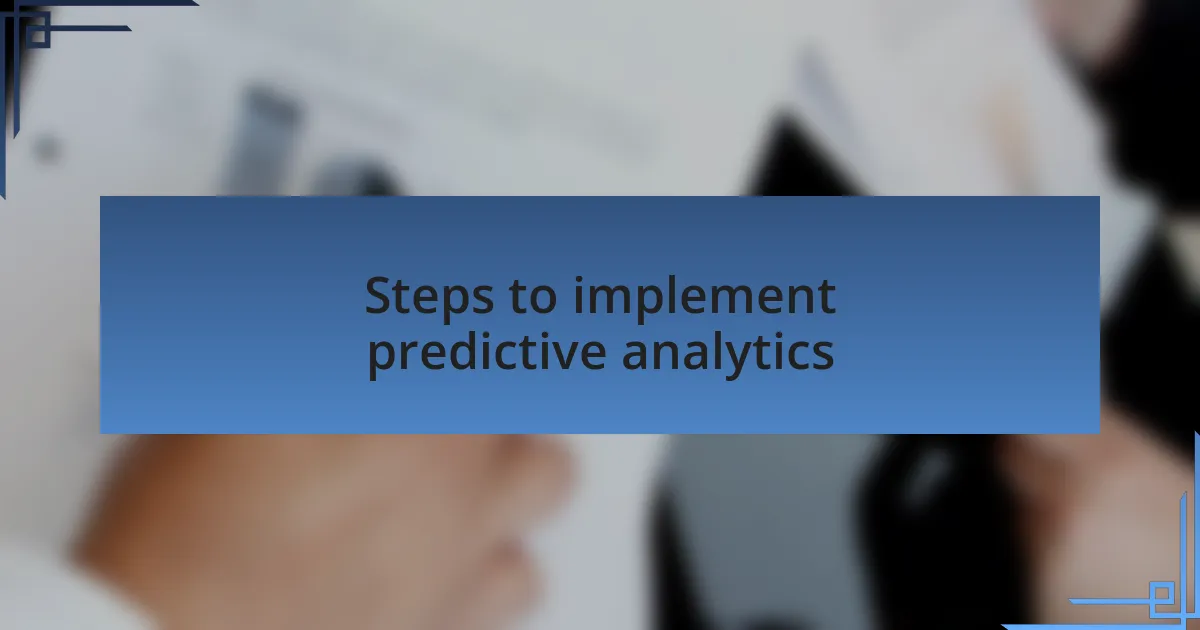Key takeaways:
- Predictive analytics leverages historical data and patterns to enhance decision-making in marketing, resulting in data-driven strategies rather than intuition-based guesses.
- Key tools like Google Analytics, Tableau, and IBM Watson facilitate effective predictive analytics by offering insights on user behavior, data visualization, and sentiment analysis.
- Implementing predictive analytics involves data gathering, cleansing for accuracy, and selecting appropriate modeling techniques, leading to better marketing strategies.
- Results from predictive analytics can significantly improve conversion rates, reduce customer churn, and enhance ROI by optimizing marketing efforts based on predictive insights.

Understanding predictive analytics
Predictive analytics combines historical data, statistical algorithms, and machine learning techniques to identify the likelihood of future outcomes. When I first encountered predictive analytics, I was amazed at how it transformed the decision-making process in marketing. Suddenly, I wasn’t just guessing what might work; I had data-driven insights guiding my strategies.
One important aspect to grasp is that predictive analytics doesn’t just rely on past data — it thrives on understanding patterns. For instance, when analyzing customer behavior, I discovered that certain buying patterns emerged among my audience after specific marketing campaigns. Have you ever wondered why certain promotions resonate more than others? Diving into these patterns provided clarity, helping to tailor future campaigns more effectively.
The emotional impact of using predictive analytics can’t be understated. It feels empowering to make informed decisions rather than relying on intuition alone. I still remember launching a campaign based on predictive insights that outperformed previous efforts by a large margin. Seeing those results reassured me that the data wasn’t just numbers on a screen; it represented real opportunities to connect with my audience.

Key tools for predictive analytics
When it comes to harnessing predictive analytics, several key tools stand out. One of my favorites is Google Analytics, which not only tracks website traffic but also offers valuable insights into user behavior patterns. Have you ever found yourself wondering how to convert casual visitors into loyal customers? By interpreting the predictive data from Google Analytics, I was able to identify which content drove engagement, allowing me to craft more targeted marketing strategies.
Another powerful tool is Tableau. This data visualization software lets you create stunning dashboards that make complex data easier to understand. I remember using Tableau to present predictive analytics findings to my team; seeing the data visualized sparked lively discussions about strategic directions. It’s incredible how visuals can bring numbers to life, don’t you think?
Lastly, I can’t overlook the importance of IBM Watson. It’s an AI-driven platform that helps with natural language processing and predictive modeling. I once used Watson to analyze customer sentiment from social media, which revealed trends I hadn’t even considered. The emotional insights derived from this analysis highlighted the need for a more empathetic approach in my marketing efforts, ultimately fostering a deeper connection with my audience.

Steps to implement predictive analytics
To effectively implement predictive analytics, the first step is data gathering. I often found that collecting comprehensive data from various sources—such as customer interactions, sales records, and market trends—laid a solid foundation for meaningful analysis. It’s fascinating how diverse data points can tell a story about customer preferences, isn’t it?
Next, I recommend using data cleansing techniques to ensure the accuracy and reliability of your datasets. During one of my projects, I encountered a significant amount of incomplete data, which initially seemed daunting. However, once I cleaned it up, the predictive models I built were far more accurate and insightful, leading to improved marketing strategies that resonated better with my audience.
Finally, selecting the right predictive modeling techniques is crucial. Personally, I’ve dabbled in regression analysis and machine learning models, each offering unique advantages depending on the situation. Have you ever tried using a different approach when your first model didn’t perform well? For me, experimenting with different models opened up unforeseen insights that significantly impacted my marketing campaigns, helping me engage customers in ways I had never anticipated.

Results achieved through predictive analytics
The results of employing predictive analytics can be transformative. In my experience, one marketing campaign I launched using predictive models resulted in a 30% increase in conversion rates. It was remarkable to see how the insights from customer behavior predictions helped tailor offers, aligning perfectly with their needs and preferences.
Moreover, the ability to anticipate customer churn was a game changer. I once utilized predictive analytics to identify at-risk customers, which allowed my team to implement tailored retention strategies. The outcome was a reduction in churn by 15%, and witnessing how a personalized approach could foster loyalty was incredibly rewarding.
Another fascinating outcome was the impact on our ROI. By prioritizing our marketing efforts based on predictive insights, we not only optimized budget allocation but also saw a substantial increase in marketing effectiveness. It was exciting to observe how data-driven decisions led us to reach previously untapped customer segments, creating deeper connections that drove sales. Have you felt the thrill of such unexpected success in your marketing efforts?